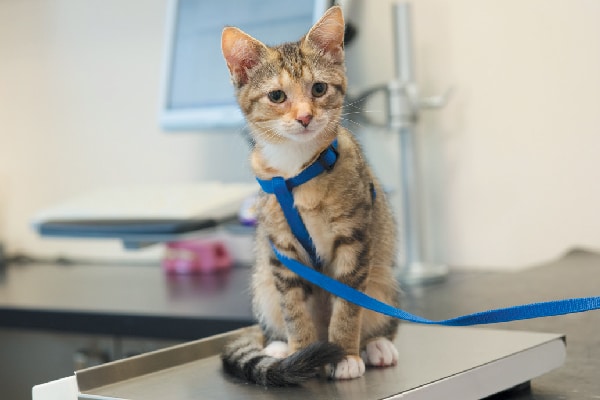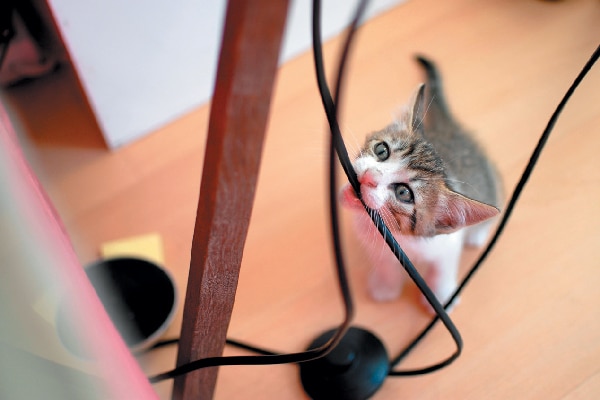When a kitten joins your family, a prompt visit to the veterinarian’s office can get you started on vaccines and help determine if there are any current health concerns. Routine tests and an examination will tell a doctor a lot about a cat’s health.
Test early for these feline diseases

“You should consider the possibility of feline leukemia and feline immunodeficiency virus (feline AIDS), two incurable viruses that can be passed from queen to kittens,” says Lou Anne Wolfe, DVM, of the Will Rogers Animal Hospital in Oklahoma. “Your veterinarian can do a simple blood test on your kitten, which only takes a few minutes. One common in-clinic antigen test checks for leukemia, FIV and heartworms.”
Feline leukemia and feline immunodeficiency virus are not contagious to humans or dogs, but they are highly contagious to other cats. If you have another cat at home, be sure to test your new kitten for these diseases. “Among the general cat population, the viruses are transmitted by saliva. Cat-fight bite wounds are the most common vehicle, but eating and drinking after one another is another transmission mode.”
Other common cat health issues
Other common health issues to look out for are external parasites (like fleas), internal parasites (like tapeworms), ringworm and upper-respiratory infections, says Paula A. Monroe-Aldridge, DVM, of River Trail Animal Hospital in Tulsa, Oklahoma, and president of the American Association of Feline Practitioners.
“We commonly think of worms as intestinal parasites, but there are other intestinal parasites as well,” she says. “Two other common intestinal parasites that are not worms are Coccidia and Giardia. The symptoms of intestinal parasites can include diarrhea, vomiting, poor body condition and/or bloated abdomen. It is possible for a cat to be infected with intestinal parasites and not have any symptoms at all.”
Ringworm can throw people off because it’s a fungus (not an actual worm) and can transfer to humans and other animals in the home fairly easily. “The symptoms of ringworm can include scratching, hair loss and crusty lesions of the skin,” Dr. Monroe-Aldridge says.
For external parasites, such as ear mites, fleas and ticks, look out for head shaking, black debris in the ears and flea “dirt” in a cat’s fur, which looks like specks of black pepper. Working with a veterinarian to choose appropriate flea control can reduce the chance of disaster. Consulting with vets will ensure that kittens and cats are receiving the appropriate medication for the correct species (accidents can happen) and that the dosage matches the age and weight of the feline recipient.
Medications for kitty
Along those same lines, any medication given to kittens and cats should be formulated for the feline species. Doug Mader, DVM, of the Marathon Veterinary Hospital in Marathon, Florida, says he’s known of people giving their cats human medication, such as Tylenol. “Owners think they are doing a favor to their pets, but it is toxic,” he says.
Also consider a life indoors for your cats. With proper stimulation, such as toys, playtime, scratching posts and cat trees, cats living inside are perfectly happy. They’re also much safer. “I do not recommend that cats go outdoors unless on a leash,” Dr. Mader says. “There are many dangers outside, like disease, automobiles, big dogs, other mean cats and so on. And also, outdoor cats are the No. 1 cause of death to wildlife, such as birds and small rodents.”
Common health problems for adult cats
As your cat matures into adulthood, there are other ailments to look out for. Know your cat’s regular habits and behavior for the first step in prevention. “Cats age at a more accelerated rate than humans and can hide diseases exceptionally well,” Dr. Monroe-Aldridge says. “These are two reasons routine visits to the veterinarian are so very important, even for indoor cats. Cats are very routine creatures, and owners should be concerned with any deviation from normal activities.”
Common medical conditions to watch for in adults can include diabetes, kidney disease, cancer, heart disease and urinary-tract infections. UTIs are fairly common, especially in males.
“Usually the first clue is inappropriate urination: on your bed, in the bathtub, even on a stove burner — this has actually happened!” Dr. Wolfe says. “Urinary-tract infections can produce urinary crystals in cats. This is particularly critical in a male cat, which can accumulate the crystals in his urethra and become plugged.” When a cat’s urethra becomes blocked, the bladder fills with urine but it has nowhere to go. This is a true medical emergency, as the bladder can burst if it’s not treated fast. “Your veterinarian will place a urinary catheter to relieve the pressure and discomfort. This is a difficult condition to anticipate, but one clue may be frequent litter box visits and ‘posturing’ to urinate with no results.”
Monitor your cat and bring her to the vet for regular checkups to help keep her healthy and fend off preventable conditions. Thinking of a vet as a partner in your cat’s health will go a long way and lead to a happier life for your feline friend.
Signs that your cat is sick

Changes in your cat’s behavior or physical appearance could signal potential medical issues. Because cats are masters of hiding their illnesses, keep an eye on them and familiarize yourself with their routines. Some things to watch for include:
- Bad breath
- Change in litter box habits (going outside the box, an increase or decrease in urination or defecation, straining in the litterbox, blood in the urine or feces)
- Change in grooming habits (poor hair coat or overgrooming)
- Frequent vomiting (aside from the occasional hairball, it is not “normal” for a cat to vomit)
- Diarrhea or hard/dry feces
- Weight loss/weight gain
- Increase or decrease in appetite
- Increase in water consumption
- Coughing
- Lethargy
- Increased vocalization
Bad plants for cats

Before bringing home houseplants or flowers, check against a complete list of potential hazards to cats. Here’s a brief list to get you started. Find a full list at aspca.org/pet-care/animal-poison-control/toxic-and-non-toxic-plants
- Aloe
- Azalea
- Chrysanthemum
- Lily
- Marijuana
- Mistletoe
- Poinsettia
- Rhododendron
- Tulip
Toxic foods for cats
Cats should stick to food and treats formulated just for them, as some human foods can be toxic to cats.
Here’s a brief list. You can find the full list at aspca.org/pet-care/animal-poison-control/people-foods-avoid-feeding-your-pets and aspcapro.org/resource/people-foods-pets-should-never-eat.
- Chocolate
- Onions
- Caffeine
- Grapes
- Raisins
Kitten- or cat-proof your home before bringing a kitty into it!

Much like with human babies, a home with a kitten needs “babyproofing” to prevent potential health hazards.
“Hazardous items include yarn, string, thread; rubber hair elastics; bread twist-ties, rubber bands; artificial icicles on Christmas trees,” says Lou Anne Wolf, DVM. If any of these items are ingested, it can cause serious health issues that can even lead to death. Keep toilet lids closed, keep kittens away from electric cords, and make sure they can’t get stuck in any weird nooks and crannies around the house. The adage about “curiosity killed the cat” has an element of truth in it.
Elisa Jordan is a Southern California freelance writer specializing in pets. She has a terrier, Gidget, and a cat, Izzy.
Editor’s note: This article appeared in Kittens, a special issue from Catster magazine. Look for Kittens on a newsstand near you!








